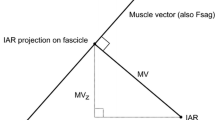Summary
Ten anatomical preparations and 15 MRI scans (Magnetic Resonance Imaging) performed on healthy subjects were used to define accurately the lateral attachments and anatomical boundaries of the supraspinatus m. Using 5 frozen specimens sectioned in the plane corresponding to the sagittal oblique MRI plane, it was possible to calculate quantitatively the ratio between the bony contours (O) and muscles (M) of the supraspinous fossa. This ratio was maximal (O/M=2.4) for the section passing through the plane which included the coracoid process anteriorly and the spine of the scapula posteriorly (“Y” section). Five dissections on unembalmed subjects demonstrated that the postero-lateral origin of supraspinatus m. extended further laterally than classically described. This observation was confirmed in the 15 MRI subjects which showed that the supraspinatus m. may arise as far laterally as the “Y” section on MRI in 53% of cases. A quantitative evaluation of atrophy of the supraspinatus m. using MRI is possible with a knowledge of these two parameters.
Résumé
Dix préparations anatomiques et 15 IRM (Imagerie par Résonance Magnétique) sur sujets sains ont été utilisées pour préciser les insertions latérales du m. supra-épineux et les limites de sa loge d'insertion. Cinq préparations congelées et coupées dans le plan correspondant à celui de l'incidence sagittaleoblique de l'IRM, ont permis de calculer le rapport quantitatif entre les contours osseux (O) et musculaires (M) de la fosse supra-épineuse: ce rapport est maximal (O/M=2,4) pour une coupe passant dans le plan comprenant le processus coracoïde en avant et l'épine de la scapula en arrière (coupe en Y). Cinq dissections sur sujets non embaumés ont montré que l'insertion postéro-latérale du m. supra-épineux s'étendait latéralement au delà des insertions classiquement décrites. Cette observation a été confirmée par 15 IRM sur sujets témoins qui ont montré que le m. supra-épineux présentaient encore des insertions au niveau de la coupe IRM “en Y” dans 53 % des cas. La connaissance de ces deux paramètres permet de proposer une technique d'évaluation quantitative de l'atrophie du m. supra-épineux à l'aide de l'IRM.
Similar content being viewed by others
References
Basmajian JV (1976) Supra-spinatus muscle. In: Primary Anatomy. Williams and Wilkins, Baltimore, pp 158–159
Burkhart SS (1994) Reconcieling the paradox of rotator cuff versus debridement: A unified biomechanical rationale for the treatment of rotator cuff tears. Arthroscopy 10: 4–19
Clark JM, Harryman DT (1992) Tendons, ligaments, and capsule of the rotator cuff. Gross and microscopic anatomy. J Bone Joint Surg [Am] 74-A: 713–725
Gagey N, Gagey O, Bastian G, Lassau JP (1990) The fibrous frame of the supraspinatus muscle. Surg Radiol Anat 12: 291–292
Gardner E, Gray DJ, O'Rahilly R (1975) Anatomy: a regional study of human structure. Saunders, Philadelphia London Toronto, pp 101–102
Goutallier D, Postel JM, Bernageau J, Lavau L, Voisin MC (1994) Fatty degeneration in cuff ruptures. Pre- and postoperative evaluation by CT scan. Clin Orthop 304: 78–83
Itoi E, Berglund LJ, Grabowski JJ, Shultz FM, Growney ES, Morrey BF, An KA (1995) Tensile properties of the supraspinatus tendon. J Orthop Res 13: 578–584
Lieber RL, Fridén J (1993) Neuromuscular stabilization of the shoulder girdle. In: FA Matsen, FH Fu, RJ Hawkins (eds) The shoulder: a balance of mobility and stability. Am Acad Ortho Surg, Rosemont, pp 91–105
Nakagaki K, Osaki J, Tomita Y, Tamai S (1994) Alterations in the supraspinatus belly with rotator cuff tearing. Evaluation with magnetic resonance imaging. J Shoulder Elbow Surg 3: 88–93
Vahlensieck M, Haack KA, Schmidt HM (1994) Two portions of the supraspinatus muscle: a new finding about the muscle macroscopy by dissection and magnetic resonance imaging. Surg Radiol Anat 16: 101–104
Warner JJP, Krushell RJ, Masquelet A, Gerber C (1992) Anatomy and relationship of the suprascapular nerve: anatomical constraints to mobilization of the supraspinatus and infraspinatus muscles in the management of massive rotator-cuff tears. J Bone Joint Surg [Am] 74-A: 36–45
Author information
Authors and Affiliations
Rights and permissions
About this article
Cite this article
Thomazeau, H., Duval, J.M., Darnault, P. et al. Anatomical relationships and scapular attachments of the supraspinatus muscle. Surg Radiol Anat 18, 221–225 (1996). https://doi.org/10.1007/BF02346130
Received:
Accepted:
Issue Date:
DOI: https://doi.org/10.1007/BF02346130




